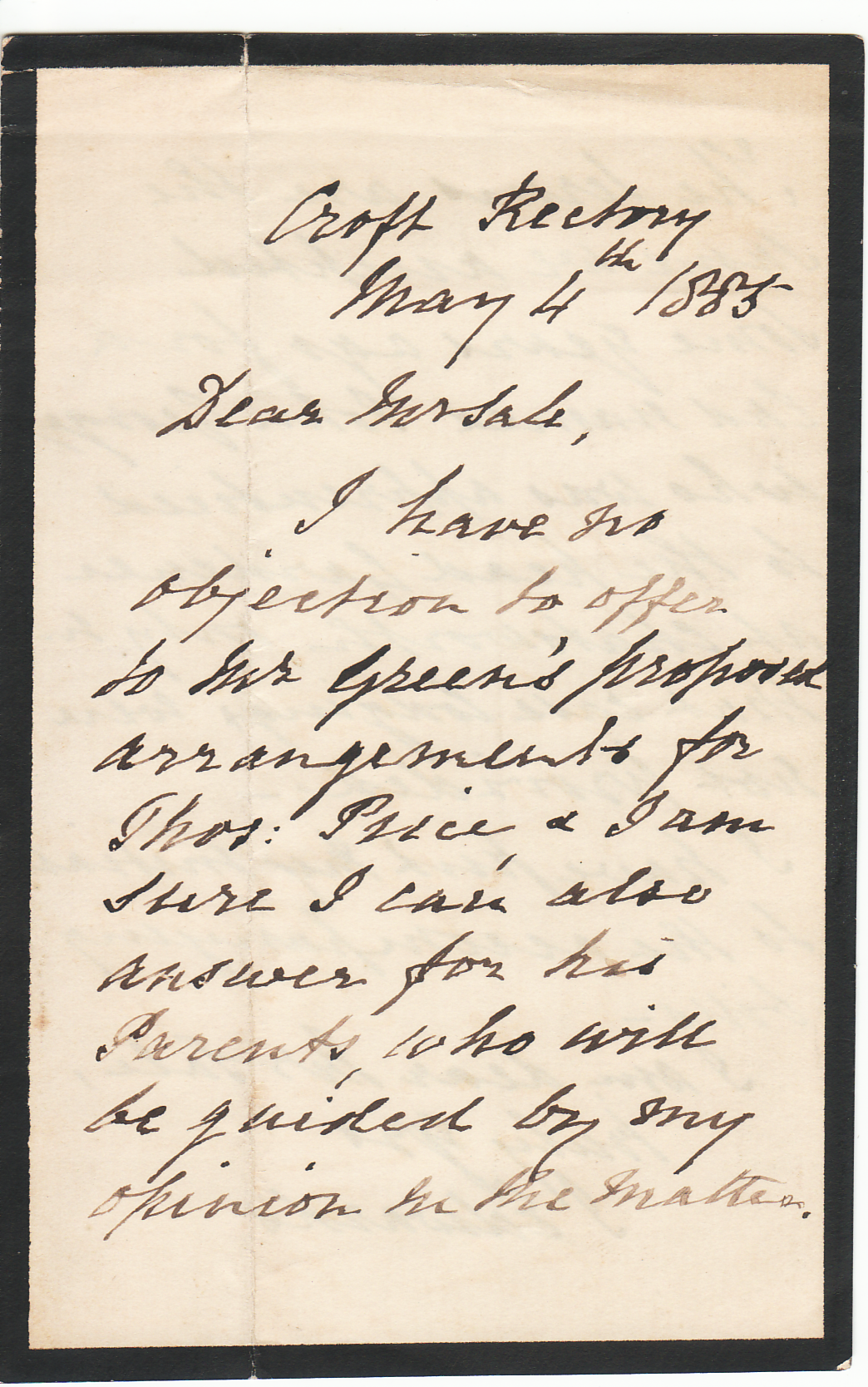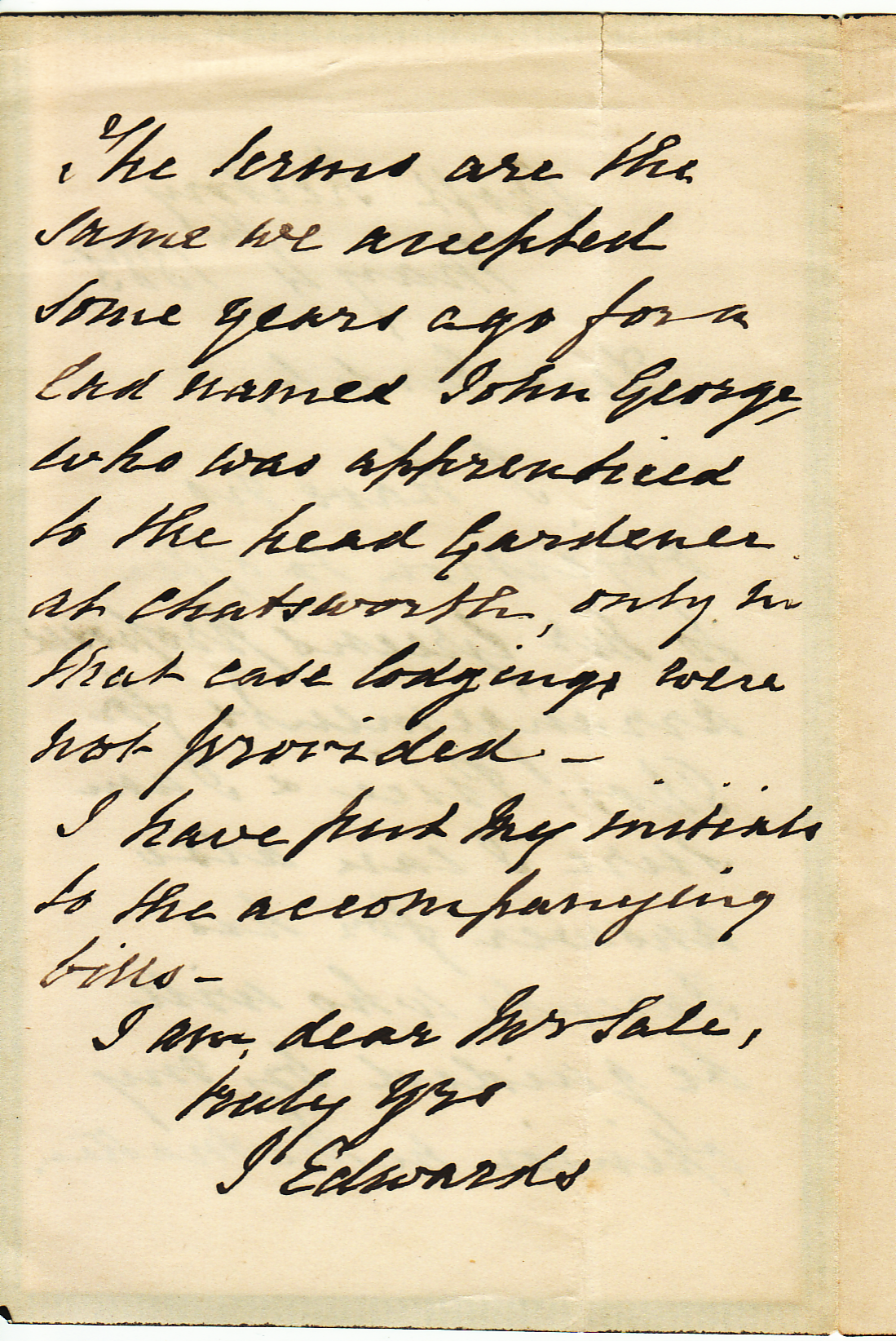A Letter from Rev. Joseph Edwards, 4th May 1885 – Context and Analysis
Letter Summary
 This two-page letter, dated May 4th, 1885, is written by Reverend Joseph Edwards, then Rector of Croft, Herefordshire. It is addressed to a “Mr. Sale” and discusses the proposed apprenticeship of a young man named Thomas Price under arrangements by a Mr. Green. Edwards states he has no objection to the proposal and believes Thomas’s parents will also accept it, trusting his opinion. He goes on to compare the arrangement to one made years earlier for another lad, John George, who was apprenticed to the head gardener at Chatsworth, one of the grandest estates in England.
This two-page letter, dated May 4th, 1885, is written by Reverend Joseph Edwards, then Rector of Croft, Herefordshire. It is addressed to a “Mr. Sale” and discusses the proposed apprenticeship of a young man named Thomas Price under arrangements by a Mr. Green. Edwards states he has no objection to the proposal and believes Thomas’s parents will also accept it, trusting his opinion. He goes on to compare the arrangement to one made years earlier for another lad, John George, who was apprenticed to the head gardener at Chatsworth, one of the grandest estates in England.
The letter concludes with Edwards confirming he has initialled the accompanying bills and signs off with “Truly yours, J. Edwards.”
About the Author: Rev. Joseph Edwards (c.1812–1886)
-
Born: ~1812, Truro, Cornwall
-
Married: October 1838, Newton Abbot, Devon, to Amelia Hamilton Keyse
-
Died: 8 June 1886, Croft Rectory, Herefordshire, aged 74
-
Occupation: Church of England clergyman and long-serving Rector of Croft (likely for several decades)
A Tragic Family Connection
 Joseph Edwards was married to Amelia Hamilton Keyse, making him the brother-in-law of Emma Ann Whitehead Keyse—the murdered spinster of Babbacombe, whose violent death in 1884 became the centre of one of Victorian England’s most notorious murder cases. The man convicted and sentenced to death for the crime, John Lee, later became known as “The Man They Could Not Hang.”
Joseph Edwards was married to Amelia Hamilton Keyse, making him the brother-in-law of Emma Ann Whitehead Keyse—the murdered spinster of Babbacombe, whose violent death in 1884 became the centre of one of Victorian England’s most notorious murder cases. The man convicted and sentenced to death for the crime, John Lee, later became known as “The Man They Could Not Hang.”
This letter, written less than a year after Emma’s murder, shows Joseph Edwards continuing his clerical and community duties with calm formality. Despite the personal grief and notoriety surrounding his family, the tone is composed and dutiful.
Detailed Content Analysis
Page 1 Highlights
-
Date/Place: Croft Rectory, May 4th, 1885
-
Recipient: Mr. Ingle Sale
-
Subject: Mr. Green’s proposal to apprentice Thomas Price
-
Position: Edwards gives his approval to the arrangement and offers reassurance that the boy’s parents will defer to his judgment.
-
Tone: Formal, composed, and collaborative
Page 2 Highlights
-
Edwards references a previous case involving a boy named John George, placed with the head gardener at Chatsworth, thus giving a precedent for the current arrangement.
-
He notes that in that case, lodgings were not provided, implying they may now be included.
-
He confirms he has signed or initialled the bills that accompany the arrangement.
-
Ends with a cordial and businesslike closure.
Historical and Social Context
Apprenticeship in the Victorian Era
This letter is a classic example of how working-class or lower-middle-class boys were placed in apprenticeships through intermediaries of trust—often clergymen, landowners, or professional men. The Rector’s recommendation would carry substantial weight in such matters, both practically and morally.
Chatsworth House
Referencing Chatsworth—home of the Dukes of Devonshire—adds prestige. It indicates that John George and now Thomas Price were being placed in respected roles within major English estates, often considered a good path to long-term employment or advancement in service roles (gardening, estate management, etc.).
Tone and Subtext
There is a sense of trust, pastoral responsibility, and routine efficiency in this letter. It is deeply revealing of how clerics like Edwards played an important role in local governance, family decisions, and employment mediation.
Notably, this letter is written only eleven months after the Keyse murder, but no hint of that personal tragedy intrudes on the formal proceedings. This reflects the Victorian ethos of stoic professionalism, especially among clergy.
Historical Value
This is not merely a routine clerical letter. It is:
-
A primary source showing how social mobility and apprenticeship were negotiated.
-
A direct link to Joseph Edwards, a figure connected by marriage to the Babbacombe Murder case.
-
An example of how, even amid personal grief, life and duty continued, recorded through Edward’s steady hand.
Conclusion
This letter from Rev. Joseph Edwards, written in May 1885, offers a rare window into both local 19th-century clerical life and the real human network behind formal apprenticeships. Edwards, despite the shadow of family tragedy following the murder of his sister-in-law Emma Keyse in 1884, remains committed to his duties as Rector. The quiet authority with which he guides the affairs of Thomas Price and his family speaks volumes about the role of the Victorian clergy in upholding both moral judgment and practical social order.
A letter from Joseph Edwards, 4th May 1885. Joseph Edwards was born about 1812, in Truro, Cornwall. He was married in October 1838 in Newton Abbot, Devon. He died on June 8, 1886, at Croft Hereford, Herefordshire, at the age of 74 where he was Rector.
Mourning Stationery: Victorian Custom
During the Victorian era, black-bordered stationery was widely used to signal bereavement. The thickness of the black border often reflected the closeness of the relationship to the deceased and was typically used:
-
In the months following a death
-
In correspondence relating to family or personal matters during mourning
-
Especially by the immediate family or close relations of the deceased
Context of the Letter
-
Date: 4 May 1885 — just under six months after Emma Ann Whitehead Keyse was murdered at Babbacombe (15 November 1884).
-
Author: Rev. Joseph Edwards, Rector of Croft, Herefordshire
-
Connection: Married to Amelia Hamilton Keyse, Emma’s sister — making Emma his sister-in-law
-
Paper: Written on heavily black-bordered paper
Why It Likely Relates to Emma Keyse’s Death
-
Timing: The letter falls squarely within the customary mourning period. Six months was still within what would be considered an appropriate time to use mourning stationery.
-
Thickness of the Border: The wide black border typically denoted mourning for a close relative — in this case, a sister-in-law who lived with Amelia Keyse and was likely close to the family.
-
No Other Known Deaths: There is no record of Joseph Edwards losing any other immediate family member around this time. His own death occurred in 1886, a year later.
-
Tone of the Letter: Though the letter is composed and professional, the use of mourning paper reflects an underlying grief or ongoing observance, even in ordinary clerical duties.
Emma Keyse’s Murder: Social Impact
The brutal murder of Emma Keyse at her seaside home, The Glen, in Babbacombe — and the resulting trial of John Lee (“The Man They Could Not Hang”) — was a national scandal in late 1884 and early 1885. For the family, especially Amelia and Joseph Edwards, the event was profoundly traumatic and publicly visible.
This letter shows that while Edwards was continuing his pastoral and local responsibilities, he was also visibly observing mourning.
Conclusion
Yes, it is highly probable that the mourning border on this letter directly relates to the murder of Emma Keyse, Joseph Edwards’s sister-in-law, in November 1884. The:
-
Date of the letter (May 1885)
-
Use of thick mourning paper
-
Known family relationship
-
And absence of other known deaths in the family
… all point convincingly to this being part of Joseph Edwards’s ongoing mourning for Emma.
